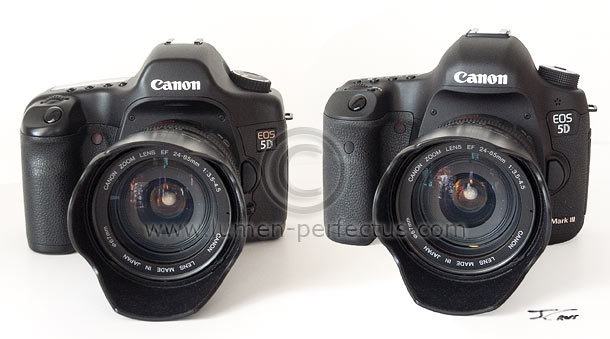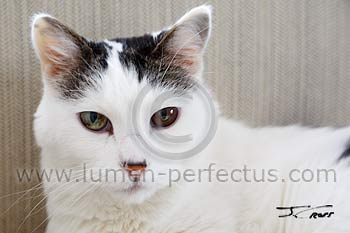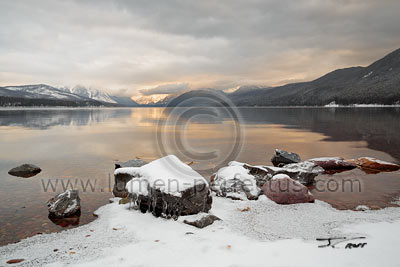www.lumen-perfectus.com
Digital Camera 2.0
“The more things change, the more they stay the same”
Attributed to Alphonse Karr.
As you can see on our “gear” page, I use Canon cameras and lenses. My EOS 5D, purchased in early 2007, has been a fine camera. Released to the market in 2005, here at the end of 2012 it's an antique, despite being an impressive camera in its prime. One of only two cameras in 2005 to offer a full-frame imaging sensor, that is, 36mm x 24mm, the size of a traditional frame of 35mm film, and at less than half the price of the other such camera, it created a sensation, and a whole new market. The camera provided excellent Image quality (IQ) and became noted for very clean high-ISO images. In 2005 that meant ISOs of 400-800.
I had no difficulty making the decision to buy the 5D. I had Canon lenses, teleconverter, extension tubes, and a few other accessories from my Canon film camera that would work well with the 5D. Shooting more landscapes (at the time) than birds or wildlife, I wanted the full-size sensor and the low-noise output. I'd have liked a higher frame rate, but the 5D's three frames-per-second seemed adequate. It appeared Canon had made the 5D just for me.
It's not a perfect camera (none is), but I've been very happy with the quality of the images I've made with it. It has been an excellent and trouble-free unit. Canon has now replaced this camera twice, first with the EOS 5D Mark II in 2008, and then with the Mark III in April, 2012 (EOS 5D timeline.)

Old, and new. My 2007-vintage EOS 5D, left, and the 5D Mark III.
Time To Move On (Or Not)
Like many, I had high-hopes for the 5D Mk III and eagerly awaited its release. I'd waited long enough; the time had come to replace my 5D. Disappointment, even dismay and (naturally) anger, ran rampant in Internet forums when Canon announced the new camera's specifications and price. This came a month after Nikon announced the D800/D800E, with an impressive feature set that included a dramatically higher pixel count and a slightly lower price. Independent testing would show the D800 also broke the mold with the highest dynamic range yet measured in a DSLR. Canon, the technology leader since the early days of the “digital revolution”, had been left in the dust by its long-time rival. It seemed nobody didn't like the new Nikons.
I immediately set aside my plans to buy a 5DIII. I wanted to learn more about the D800. I needed to understand what that camera could do for the kinds of pictures I make. The time had come to put on the lab coat and dive into research mode.
A Decision Is Made
By the middle of summer I'd decided. My goal is nothing less than to obtain the maximum IQ I can under the shooting conditions. The resolving power and the wide exposure range of the Nikons, supported by endless example photos and the tireless pixel-peeping of forum denizens, made the choice clear: I'd abandon Canon, start from scratch, buy a D800E and a couple of Nikon lenses to replace my two Canon zooms. That's where things got interesting, and where the real work began. It's also where things took an unexpected turn.
The 36.4 megapixel resolution of the Nikon sensor is a game changer in several ways. The technical explanation is beyond the scope of this article; it's been beaten to death dozens of times in the on-line forums. The short version is, the sensor out-resolves most prime lenses, and certainly out-resolves all zooms built for 35mm camera bodies. Lenses have become the weak link (OK, the photographer is the weakest link, but that's fodder for another article). Perhaps lens design, materials, and manufacturing technologies will evolve to solve the problem. That doesn't help when one needs lenses today, of course. With little knowledge of the brand and its products, I knew nothing about Nikon's lens offerings, nor did I know the affect replacing my meager collection of Canon glass with Nikon would have on my checking account.
I have only two lenses, both made by Canon. I've had them a long time; I'm comfortable with their focal-length ranges, and know how to work with their strengths and limitations. Naturally, I wanted similar, perhaps greater, capabilities in a pair of lenses for the Nikon. I'd had some success with my Canon lenses, so it seemed reasonable I could do the same with Nikon.
Got Glass?
Short of renting lenses for hands-on testing (not a bad idea!), the best one can do is read reviews, MTF charts (for what they're worth) and other data, and view sample images. I spent some weeks doing just that, studying Nikon lenses and comparing the data to that of similar lenses from Canon and others. In the end, I couldn't find a pair of Nikon lenses that suited my goals. I found Nikon's offerings to be too big, or too heavy, or lacking the sharpness I felt necessary. To be fair, neither do my current lenses, but this is to be expected in these older, low-cost lenses. If I bought the Canon body, I could shoot now with these lenses while waiting for better glass to appear on the market. If I bought the Nikon, I'd have no choice but to buy lenses now, from a selection of lenses that didn't impress me.
Friend Dean, also considering the purchase of a D800E, looked at a “kit” of Zeiss prime lenses. The numbers and test results are impressive, the lenses are small and reasonably light, and the price isn't completely insane. These are lenses that may do justice to the D800's imaging system. However, looking back through shooting data for the photos I'd made this year convinced me I'd not be happy with the focal lengths included in this set. I certainly wouldn't use all five, but looking at individual lenses from Zeiss still left significant gaps, missing focal lengths I'd wish I had. Clearly I need a zoom at the short end (say, 24mm to 70-100mm). While the idea of using the Zeiss primes, with smooth, linear focusing, real f-stop rings and DOF markings, is intriguing, auto-focus zoom lenses are the better choice for me.
Trouble in Paradise
As I researched lens options I continued to read about the D800E. I found reports of mechanical and structural issues, the kinds of problems a camera in this class should never have. The output of mass production is never perfect; one must expect the occasional defect, functional flaw, even outright failure. These kinds of issues should affect a tiny percentage of the total production. As I read more reports of such problems I became concerned about the overall reliability and longevity of the Nikon. I am intentionally not citing specific reports, nor providing details of the flaws and design issues. Google is your friend. If you're planning to spend several thousand dollars on a camera, do your research.
Canon users also report their share of design and production problems. Compared to the Nikon complaints, these may be similar, worse, or simply different flavors of the compromises necessary to get this class of camera on the market at the required price point. In any case, reports of Canon flaws and problems are more data for the decision-making mill.
Early in my research, it seemed Nikon made the best-in-class camera for me. But as I read more (with appropriate BS filters turned on, of course), I began to think the D800E has a ground-breaking image sensor in a mediocre body. The obtainable IQ is amazing, especially for landscape photographers. But Nikon's lens offerings, in my price range, are disappointing. The camera's auto-focus and frame rate, critical functions for bird and wildlife photography, are not so amazing. A couple of the reported flaws are scary, the kinds of things one shouldn't have to deal with in a $3000 camera. Friend Dean sums it up: “ If you can't get the shot, then the IQ doesn't matter.”
A Decision is Made (Again)

PC, our aged calico, poses for the required cat photo.
My Canon 5D Mark III arrived just before Christmas. As of the end of December I've been out in the field with the camera for only a few hours. I've done little more than photograph the cat (as required with any new camera) and a few landscapes in Glacier National Park, and spend some quality time with the user's manual.
For what I do the 22 megapixel resolution, nearly double what I've had since early 2007, is more than adequate. I can work within the dynamic range limits, as I always have (properly done ETTR, along with the new process version in Photoshop's Adobe Camera Raw 7/Lightroom's Develop Module, can pull excellent detail from the shadows). The auto-focus system is superior to that in the D800E, as is the rear-panel LCD, the implementation of live-view, the frame rate, and perhaps the build quality.

From my first outing with the new 5D Mark III. Low clouds over Lake McDonald and the mountains beyond, in Glacier National Park.
All in my opinion, of course. As always, “Your mileage may vary.” Many will feel differently, as they are entitled to do, and they'll get no argument from me. They can write their own articles (many have).
I'm comfortable with the camera's layout and controls. I can use my existing lenses while I watch and wait for higher quality lenses to reach the market. I expect to replace my short zoom fairly soon, and perhaps later the 100-400. I'm excited about this, and look forward to the next generation of lenses tailored to today's imaging systems.
Some Sites That Helped Along The Way
Below is a list of links to reviews, articles, and other information I found useful when sorting through all the data and BS as I researched this camera purchase. As always with a list of links, these sites may change or disappear over time, breaking the links. If you find a broken link, please let me know. You can always use your favorite search site to find more information.
December, 2012
All products and brand names mentioned are trademarks or registered trademarks of their respective owners.